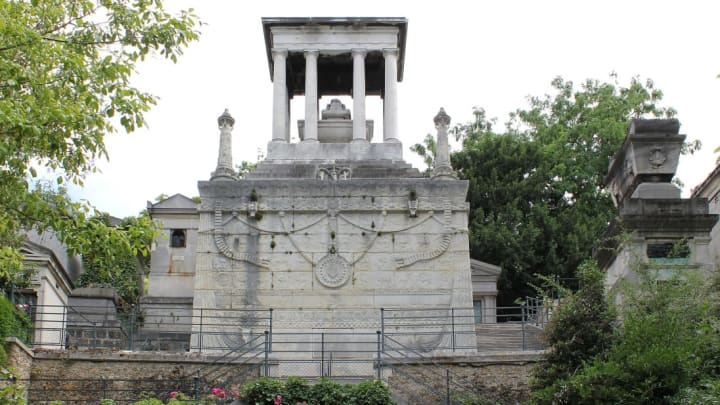Père Lachaise is the most-visited cemetery in the world. Founded in 1804, it's known for its beautiful mausoleums and tree-lined avenues, and for being the final resting place of famous figures such as Oscar Wilde and Jim Morrison. But according to legend, it's also home to the centuries-old remains of a Russian countess who might not have foreseen the cemetery's popularity. Perhaps concerned about a lack of visitors during her eternal rest, she supposedly promised the family fortune to anyone who would spend a year and a day with her in her tomb.
The legend concerns Elisabeth Demidoff (sometimes spelled Demidov; born Stroganoff/Stroganov), descendent of a Russian industrialist family who made their money in salt and fur. In life, she married the Russian count Nikolai Nikitich Demidoff, who was also heir to an industrialist fortune, this time in iron. The marriage was not a happy one, however, and the pair eventually separated, at which point Elisabeth went to live in Paris. She died at the age of 40 in 1818, and in death, it's said, she made a most unusual request.

The story goes more or less like this: After Demidoff died, her relatives were shocked to discover that her will included a provision leaving millions of francs to the person who would spend a year and a day in her elaborate white tomb alongside her body, which was resplendent in a crystal coffin. More detailed accounts add that the walls and ceiling of the tomb were covered in mirrors, so that "whichever way the watcher might turn, he or she would always be confronted by the spectacle of the dead Princess," as one widely republished newspaper story put it. The tomb's living guest was not to have any diversion except "except that of reading by the funeral light at the head of the coffin, and was condemned never to exchange a word with anyone during the 365 days, not even with the person who was once a day to bring the watcher’s food." Only in the evenings, once the gates of the cemetery were closed, or in the very early mornings, were they allowed to take a stroll around the cemetery grounds.
While many people had attempted the countess's challenge, the request had yet to be fulfilled, in part because people were driven mad while trying by "unearthly and mysterious sounds"; at least one turned into a "jabbering idiot," the newspapers said.
Alas, the story—repeated today by Parisian tour guides and paranormal enthusiasts—seems to be nothing more than the fevered product of late 19th-century newspaper writers' imaginations. (Call it the Belle Époque version of fake news.) According to the author Chris Woodyard, who specializes in writing about macabre and unusual phenomena, the earliest version appears in an 1893 Chicago Daily Tribune article (notably, seven decades after Demidoff died). Under the headings "A Chance to Grow Rich; Queer Will of a Russian Princess," the Tribune piece spells out the legend and ends by noting, "The will makes no mention of foreigners being ineligible; there is every chance therefore for a strong-minded American who fears neither ghosts, ghouls nor gravestones to become rich in the short period of 365 days. Application to be made to the municipality of Paris."
An 1896 Les Temps article unearthed by Père Lachaise researcher Marie Beleyme attributes the origins of the legend not to Chicago, but to "third page of a boulevardier newspaper," presumably in Paris. Regardless of exactly which paper started it, the story—despite being fake—had real-life effects. According to Les Temps, which said "the fable ... was reproduced everywhere in France, in Europe, in America," thousands of people wrote to the curator of Père Lachaise offering to fulfill the request. In the Paris archives, Beleyme found remnants of the craze that still exist: six letters of application, all from 1893—from the United States, Norway, Croatia, Canada, and Germany. The letters continued into 20th century, much to the exasperation of those in charge of Père Lachaise.
Today, it's not the only legend that's grown up around the countess's tomb. Demidoff is now sometimes referred to as "Vampire Baroness of Paris," apparently because wolves and other symbols in her tomb indicate a Bram Stoker-worthy connection. Needless to say, no evidence exists of Demidoff ever puncturing anyone's jugular.
Elisabeth Demidoff herself would no doubt be surprised by the accumulation of myth around her final resting place, but one thing's for sure. With millions of tourists flocking to Père Lachaise annually, she's certainly not lacking for visitors to her tomb, even if they don't usually stick around.
